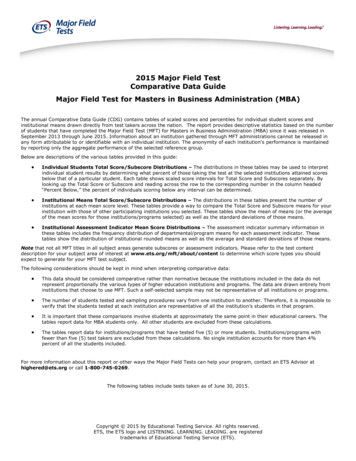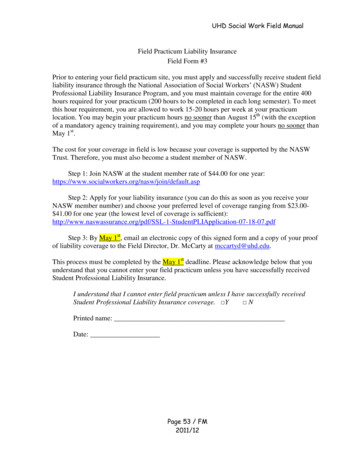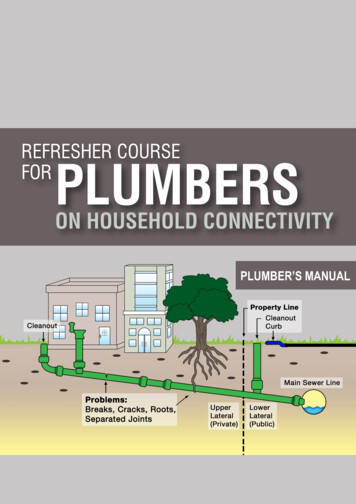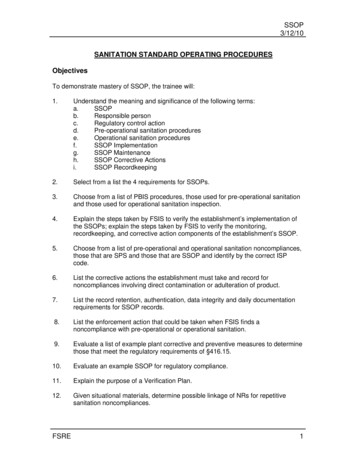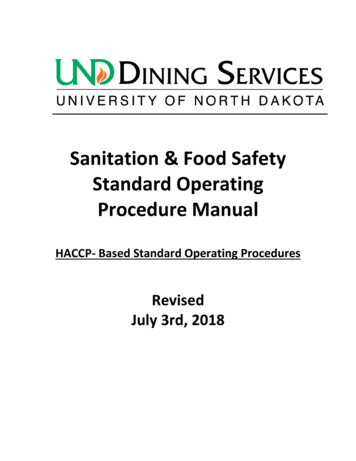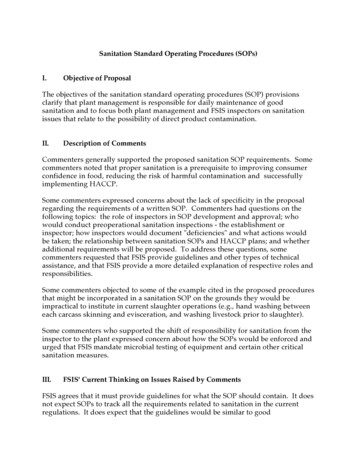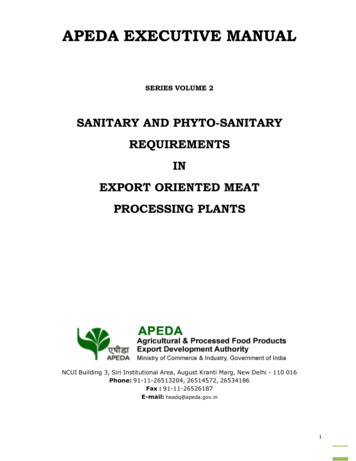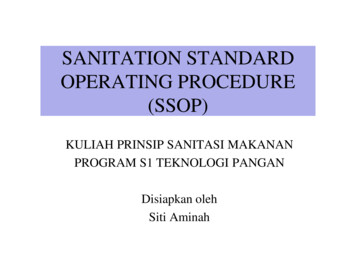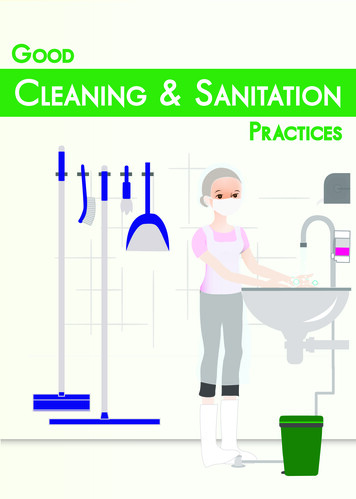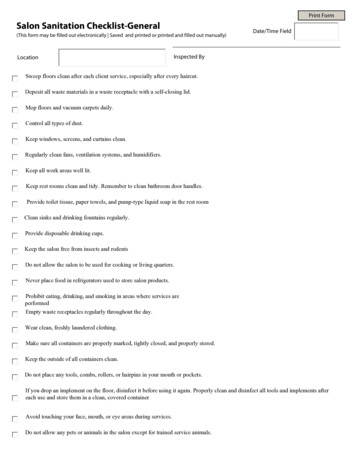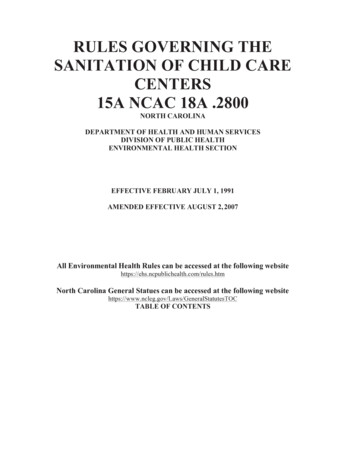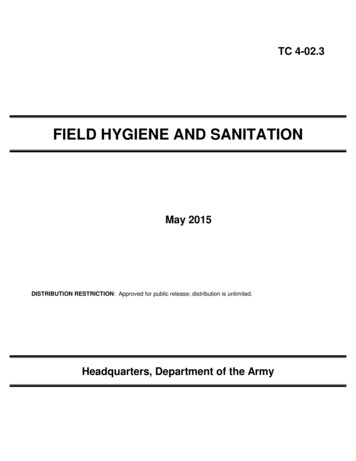
Transcription
TC 4-02.3FIELD HYGIENE AND SANITATIONMay 2015DISTRIBUTION RESTRICTION: Approved for public release; distribution is unlimited.Headquarters, Department of the Army
This publication is available at Army Knowledge .html).To receive publishing updates, please subscribe athttp://www.apd.army.mil/AdminPubs/new subscribe.asp.
*TC 4-02.3Training Circular (TC)No. 4-02.3HeadquartersDepartment of the ArmyWashington, DC, 6 May 2015Field Hygiene and SanitationContentsPagePREFACE . iiiINTRODUCTION . ivChapter 1HEALTH THREATS IN MILITARY OPERATIONS . 1-1Disease and Nonbattle Injuries . 1-1Health Threats . 1-2Predisposing Factors . 1-2Preventive Medicine Measures . 1-2Chapter 2INDIVIDUAL PREVENTIVE MEDICINE MEASURES . 2-1Soldier Responsibilities . 2-1Personal Hygiene. 2-1Oral Hygiene . 2-4Sanitation . 2-4Waste Management in the Field . 2-5Physical Fitness . 2-6Water- and Foodborne Illness . 2-6Arthropods, Rodents, and Other Animal Threats . 2-6Immunizations and Chemoprophylaxis . 2-7Heat Injury . 2-8Cold Injury. 2-8Toxic Industrial Materials . 2-9Protect Self and Mission From Toxic Industrial Materials. 2-10Noise Hazards . 2-11Sleep Deprivation . 2-11Chapter 3UNIT-LEVEL PREVENTIVE MEDICINE MEASURES . 3-1Leader Responsibilities . 3-1Plan and Prepare for Hot Weather Operations . 3-4Distribution Restriction: Approved for public release; distribution is unlimited.*This publication supersedes FM 21-10/MCRP 4-11.1D dated 21 June 2000.i
ContentsPlan and Prepare for Cold Weather Operations . 3-5Plan for and Enforce Preventive Measures for Carbon Monoxide Poisoningand Fire Prevention . 3-6Plan for and Enforce Preventive Measures for Toxic Industrial Materials . 3-7Plan for and Enforce Protective Measures for Noise Hazards . 3-7Plan for and Enforce Sleep Discipline . 3-7Ensure Welfare, Safety, and Health of the Unit . 3-8Appendix ATECHNIQUES AND PROCEDURES FOR DISINFECTING WATER . A-1GLOSSARY .Glossary-1REFERENCES . References-1INDEX . Index-1TablesTable 1-1. Percentage of disease and nonbattle injury rates in contemporaryoperations . 1-1Table A-1. Chlorine dose calculator using five percent unscented household bleachand 70 percent high-test hypochlorite . A-3Table A-2. Equivalent volumes chart . A-3Table A-3. Instructions for using the chlorination kit (water purification) . A-5Table A-4. Chlorination kit (water purification) tablet or powder sachet additioninstructions. A-6iiTC 4-02.36 May 2015
PrefaceTraining Circular (TC) 4-02.3 provides hygiene and sanitation guidance for Soldiers in the field and whiledeployed. The publication outlines individual and leader responsibilities and describes individual and leaderpreventive medicine measures and guidance for Soldiers. Implementation of the techniques presented in thispublication enable individual Soldiers to remain healthy in the field and enable commanders to maintain a fitand healthy force capable of accomplishing the mission in any environment.The principal audience for TC 4-02.3 is commanders, subordinate leaders, individual Soldiers, Department ofDefense (DOD) civilians and contractors.Commanders, staffs, and subordinates ensure their decisions and actions comply with applicable United States(U.S.), international, and, in some cases, host-nation laws and regulations. Commanders at all levels ensuretheir Soldiers operate in accordance with the law of war and the rules of engagement. (See Field Manual [FM]27-10.)This publication is in consonance with the following North Atlantic Treaty Organization StandardizationAgreements:TitleNorth Atlantic Treaty OrganizationStandardization AgreementsRequirement for Training in First-Aid, Emergency Care in CombatSituations and Basic Hygiene for All Military Personnel2122Requirements for Water Potability During Field Operations and inEmergency Situations—Allied Medical Publication-4.92136Emergency Supply of Water in Operations2885Protection of Hearing2899Essential Field Sanitary Requirements2982This publication uses joint terms where applicable. Selected joint and Army terms and definitions appear inboth the glossary and the text. This publication is not the proponent for any Army terms.Unless otherwise stated in this publication, the use of masculine nouns and pronouns does not refer exclusivelyto men.Training Circular 4-02.3 applies to the Active Army, Army National Guard/Army National Guard of the UnitedStates, and United States Army Reserve unless otherwise stated.The proponent and the preparing agency of this publication is the United States Army Medical DepartmentCenter and School, United States Army Health Readiness Center of Excellence. Send comments andrecommendations on a DA Form 2028 (Recommended Changes to Publications and Blank Forms) toCommander, United States Army Medical Department Center and School, United States Army Health ReadinessCenter of Excellence, ATTN:MCCS-FC-DL (TC 4-02.3), 2377 Greeley Road, Building 4011,Suite D, JBSA Fort Sam Houston, Texas 78234-7731; by e-mail to rine@mail.mil; or submit an electronic DA Form 2028. Recommendedchanges should be keyed to the specific page, paragraph, and line number. A rationale for each proposedchange is required to aid in the evaluation and adjudication of each comment.6 May 2015TC 4-02.3iii
IntroductionTraining Circular 4-02.3 remains generally consistent with FM 21-10/MCRP 4-11.1D on keytopics while adopting updated terminology and concepts as necessary. It is designed to beused in conjunction with Army Techniques Publication (ATP) 4-25.12.The material presented in this publication reflects enduring practices of field hygiene,sanitation, and preventive medicine measures. Implementation of these techniques andprocedures enable commanders to preserve the health of their Soldiers in order for them toaccomplish the units’ mission. Additionally the discussion contained in this text is designed asa quick reference and ready resource for the individual Soldiers to employ appropriatepreventive medicine measures to protect themselves from health threats commonlyencountered while in the field or deployed.Summary of changes include—The revision of FM 21-10/MCRP 4-11.1D includes designating this publication as a TC andrenumbering it as TC 4-02.3 in compliance with the Army’s Doctrine 2015 Initiative.Training Circular 4-02.3 consists of three chapters and one appendix as follows:Chapter 1 provides a brief history of disease in military operations, identifies health threatsconfronted by Soldiers while in the field or deployed, and introduces preventive medicinemeasures.Chapter 2 identifies individual preventive medicine measures and responsibilities.Chapter 3 identifies leader responsibilities and collective preventive medicine measures.Appendix A provides information on water purification techniques for individual water storagesystems.ivTC 4-02.36 May 2015
Chapter 1Health Threats in Military OperationsDISEASE AND NONBATTLE INJURIES1-1. Disease and nonbattle injuries (DNBIs) have been a costly consequence of military operations for aslong as there have been armies. Historically around 80 percent of reported casualties among U.S. militarypersonnel have been attributed to DNBI. The result has been tens of thousands of U.S. military personnelwho have died, were severely disabled, or temporarily rendered incapable of performing their duties. Highnumbers of DNBI casualties has had a significant impact on unit readiness and severely jeopardized theability of some units to accomplish their mission.Note. Disease and nonbattle injury casualties are defined as Soldiers who are lost to theirorganization by reason of disease or injury and who are not battle casualties.1-2. To reduce the high rates of DNBI, the armed forces of the U.S. implemented fundamental changes inthe way that they address field hygiene and sanitation and health threats endemic to an area of operations.Although incidences of DNBI have declined since the end of the Vietnam War there is no doubt that theystill adversely affect U.S. military forces. Table 1-1 depicts percentages of DNBI recorded in U.S. militaryoperations from 1991 to 2003.Table 1-1. Percentage of disease and nonbattle injury rates in contemporary operationsPercentage of casualties attributed to disease and nonbattle injury by operation and dateOperation Desert Shield/Desert Storm, 19916.5 percentOperation Joint Endeavor, 19957.1 percentOperation Joint Guardian, 19998.1 percentOperation Enduring Freedom, 20015 percentOperation Iraqi Freedom, 20034 percent1-3. The reduction in DNBI casualty rates can be attributed to— Command emphasis. Proactive leaders and unit field sanitation teams. Awareness of the threat. Education and training. Ready access to safe rations, potable water, laundry, shower, and latrine facilities. Improved preventive medicine measures, personal protection equipment, and chemoprophylaxisand medical treatment protocols.6 May 2015TC 4-02.31-1
Chapter 1HEALTH THREATS1-4. The environments in which U.S. military forces routinely operate present significant health threats toSoldiers in the field and when deployed. Health threats most commonly encountered by U.S. militarypersonnel include— Endemic diseases. Food- and waterborne diseases. Hazardous plants and animals. Entomological hazards (nuisance pests and disease-carrying vectors). Toxic industrial materials (industrial and agricultural). Deployment-related stress. Sleep deprivation. Hazardous noise. Climatic or environmental extremes (heat, cold, high altitudes).PREDISPOSING FACTORS1-5. Predisposing factors are things which make a Soldier more susceptible to becoming a DNBI casualty.These include— Breakdown in basic hygiene and sanitation practices. Weakening of the natural defenses of the human body. Harshness of the environment.BREAKDOWN IN BASIC HYGIENE AND SANITATION PRACTICES1-6. Basic hygiene and sanitation practices may begin to breakdown when Soldiers are not able to readilyand regularly access potable water, safe rations, showers, latrines, and laundry facilities. Soldiers maybecome apathetic and begin neglecting their personal hygiene and fail to properly dispose of potentiallyhazardous solid and human waste products.NATURAL DEFENSES OF THE HUMAN BODY1-7. Extended periods of time in the field and prolonged deployments in austere environments placetremendous stress on the human body. These stresses can negatively impact the body’s natural defensemechanisms and can weaken its ability to efficiently protect against disease. When Soldiers are placed inhigh-stress situations for extended periods of time coupled with significant climatic changes, interruptedsleep periods or sleep deprivation, and irregular meals they become more susceptible to illness and injury.HARSHNESS OF THE ENVIRONMENT1-8. Harsh environments are a reality of U.S. military operations. Conducting operations in theseenvironments exposes Soldiers to extremes of heat or cold, high altitude environments, endemic diseases,food- and waterborne disease, hazardous pests and animals, entomological hazards, toxic industrialmaterials (industrial and agricultural), deployment-related stress, and hazardous noise.PREVENTIVE MEDICINE MEASURES1-9. Preventive medicine measures are simple, common sense actions that every Soldier can and mustperform to preserve his health and avoid unnecessary injury while in the field or when deployed.Note. In order to be effective, preventive medicine measures must be an item of command interest.1-2TC 4-02.36 May 2015
Health Threats in Military Operations1-10. The principles of preventive medicine measures are— Soldiers perform individual techniques of preventive medicine measures. Field sanitation teams train Soldiers in preventive medicine measures and advise commandersand unit leaders on implementation of unit-level preventive medicine measures. Commanders and subordinate leaders provide for and enforce preventive medicine measures.1-11. The key point to remember is that disciplined, well trained, physically fit, and appropriatelysupported Soldiers can avoid becoming DNBI casualties and remain healthy to successfully perform theirmission while in the field and deployed. This is especially true when they are aware of the threats present intheir area of operations and provided the information and resources necessary to counter the threat.6 May 2015TC 4-02.31-3
This page intentionally left blank.
Chapter 2Individual Preventive Medicine MeasuresSOLDIER RESPONSIBILITIES2-1. Regulations state that individual Soldiers are responsible for their own well-being. For example, AR40-5 states that every Soldier is responsible for his own well-being and that he will implement and employall protective measures possible to preserve his health. Each Soldier, as a minimum, will protect against— Skin diseases by washing the body as often as practicable. Heat injury in hot and sunny climates by following work or rest and water consumptionguidelines, by properly adhering to uniform wear policies, and by using sunscreen on exposedbody parts. Cold injury in cold climates by wearing proper cold-weather clothing and frequently changingsocks to keep feet dry, by careful handling of gasoline-type liquids, and by avoiding contactbetween skin and cold metal. Mosquito, fly, tick, and other arthropod-borne diseases by using insect repellents, netting, andinsecticide aerosols; by taking approved chemoprophylaxis; and by wearing the uniformproperly. Enteric (gastrointestinal) diseases by using water purification procedures whenever water qualityis uncertain and by avoiding foods prepared by unapproved food vendors, and by properlydisposing of bodily wastes. (Refer to Appendix A for water disinfection techniques andprocedures).PERSONAL HYGIENE2-2. Personal hygiene refers to a set of practices intended to preserve the health of the individual Soldierand consequently the health of every Soldier who must work and live in close proximity to them.2-3. To maintain an effective personal hygiene regimen, each Soldier must maintain a supply of personalhygiene items for use when they are going to the field or deploying.Note. Soldiers being deployed for unspecified periods of time should consider packing a 90-daysupply of prescription medications and standard toiletry articles until sustainment of these itemscan be assured.2-4. Personal hygiene items may include, but is not limited to, the following items: Absorbent body powder. Alcohol-based hand sanitizer. Antiperspirant/deodorant. Comb. Dental floss. Department of Defense-approved insect repellent. Eye drops. Feminine hygiene products. Foot powder. Hairbrush.6 May 2015TC 4-02.32-1
Chapter 2 Lip balm.Prescription medications (for example, birth control, blood pressure, and so forth).Sanitizing wipes.Shampoo.Shaving kit.Soap.Sunscreen lotion.Toilet e. Alcohol-based hand sanitizer, sunscreen, and DOD-approved insect repellents areavailable through unit supply channels for issue to Soldiers as needed.SKIN CARE2-5. The skin is the largest organ of the human body and protects the body from disease-causing bacteriaand viruses. The skin also provides protection from the direct rays of the sun, insulates the body from cold,and helps to regulate the temperature of the body in hot environments.2-6. As the body’s first line of defense it is essential that Soldiers protect their skin by keeping it as cleanas possible. Showering regularly helps to reduce bacteria that are resident on the skin and can help toprevent infection from scrapes, cuts, punctures, and cracked skin. Soldiers can protect their skin by— Showering or bathing regularly to keep the skin clean. Using absorbent body powder to control moisture buildup. Pay particular attention to areaswhere wetness is a problem (such as underarms, between the thighs and buttocks, feet, and, forfemales, under the breasts). Wearing the uniform properly and modifying the wear of the uniform when directed. Utilityuniforms are designed to fit loosely to allow for ventilation and provide protection from the sun. Wear moisture wicking undergarments designed to pull moisture away from the skin. Changing into clean dry socks and applying antifungal foot powder to protect the feet fromprolonged periods of dampness. Applying DOD-approved insect repellent when needed.Note. Use of insect repellents must always be in compliance with the manufacturer’sinstructions. Applying sunscreen to exposed skin.SHOWERING2-7. Under ideal conditions Soldiers should shower daily, or at least once every week to maintain goodpersonal hygiene.Frequent showering prevents skin infections and helps to prevent potentialparasite infestations. When showers are not available, washing daily with a washcloth and soap and water isadvised. Particular attention should be given to sweaty areas or places that become wet—armpits, feet,genitals, between thighs and buttocks, and under breasts.2-8. It is highly recommended that female Soldiers who are menstruating have daily access to showerfacilities. This however does not mean that there must be a fixed facility with hot and cold running water onsite. In situations where shower facilities are not available, female Soldiers can establish a private space2-2TC 4-02.36 May 2015
Individual Preventive Medicine Measureswith adequate drainage and bathe using a washcloth and soap and water. A full canteen of water should beadequate for one Soldier and a five-gallon water container for multiple Soldiers. Provisions for heatingwater would be preferred, but may not always be possible. The site designated for Soldiers to washthemselves must provide privacy and security.2-9. Female Soldiers who are not menstruating should be treated the same as male Soldiers with regard toaccessing fixed shower facilities. Shower runs should be coordinated without gender preference influencingtheir frequency. Soldiers should avoid using perfume, cologne, or scented soaps, which can attract insects.However, unscented lotion can be used to keep the skin from drying, cracking, and becoming infected.Cosmetics are not authorized in the field. Frequent showering also helps to prevent genital and urinary tractinfections.LAUNDERING CLOTHING REGULARLY2-10. Laundering of uniforms is critically important for preventing parasite infestation since head and bodylice are generally spread by direct contact with infested Soldiers, their uniforms, or bedding.2-11. The following are steps that can be taken to help prevent and control the spread of head and bodylice: Shower and bathe regularly and change into properly laundered uniforms at least once a week. Do not share clothing, beds, bedding, and towels used by a Soldier known to harbor parasites. Fumigation or dusting with DOD-approved insecticides may be necessary to control and preventthe spread of body lice.HAND WASHING AND SANITIZING2-12. One of the most effective practices that Soldiers can perform to protect themselves and others fromthe spread of disease is to thoroughly wash or sanitize their hands frequently. Regular washing or sanitizingof the hands denies disease-causing bacteria and viruses from gaining easy entry into the body. Soldierswho fail to wash their hands frequently increase the risk of spreading germs picked up from other sourcesand possibly infecting themselves when touching their eyes, nose, or mouth. One of the most common waysSoldiers catch a cold is by rubbing their nose or their eyes with an unwashed hand which has beencontaminated with a cold-causing virus.2-13. Germs can be spread directly to others or onto surfaces that others might touch which may causeother Soldiers around you to become sick. The important thing to remember is that, in addition to colds,serious diseases like infectious diarrhea and meningitis can easily be prevented when Soldiers make a habitof frequently washing their hands.2-14. When to wash and or sanitize the hands (at a minimum)— Before eating or snacking. After eating or snacking. Before handling or preparing food. After using the latrine. After handling anything that could potentially transfer germs. Frequently during the work day to keep your hands free of germs. After coming into contact with any local flora or fauna. After physical contact with local nationals.Note. Maintain cultural awareness to ensure that no insult is conveyed when this is done.2-15. Ways to clean or sanitize the hands is through the use of— Soap and potable water.6 May 2015TC 4-02.32-3
Chapter 2Note. Nonpotable water should only be used as a last resort. Nonpotable water may becontaminated which would negate the benefits of hand washing. Alcohol-based hand sanitizing solutions when soap and water are not available.Note. Alcohol-based hand sanitizers are not effective if the Soldier’s hands are caked with dirtor grease. Alcohol wipes (included in the accessory packet of every meal, ready-to-eat, individual) to cleanhands.Commercial cleansing wipes if available.ORAL HYGIENE2-16. The issue of oral hygiene is a readiness issue. Soldiers who fail to maintain a vigorous oral hygieneregimen can quickly become nondeployable. When neglected bacteria in the mouth use starches and sugarto produce acids that can quickly result in gingivitis and tooth decay. Not brushing for just a few days cancause inflammation of the gums and result in irritated and bleeding gums. If gum disease already exists, itcan quickly become worse. To prevent tooth decay and gum disease Soldiers must maintain good oralhygiene practices at all times by— Flossing their teeth. Brushing their teeth.FLOSSING2-17. Flossing is important because it removes food particles from between the teeth and under the gumswhere brushing cannot reach. Soldiers should floss at least once per day.BRUSHING2-18. Soldiers should brush at least twice a day, especially before sleeping. Brushing should include theuse of fluoride toothpaste to brush all the surfaces of the teeth using a circular motion. Soldiers should notrinse, eat, or drink anything for at least 30 minutes after brushing to allow the fluoride to stay on the teethlonger and protect them better. If toothpaste is not available, Soldiers should brush their teeth anyway.Brushing should include the tongue and the roof of the mouth. Soldiers can also enhance their oral hygieneby chewing the gum contained in the accessory packet of every field ration. The gum is made with asweetener that helps control the buildup of oral bacteria and reduces tooth decay when used regularly.2-19. Soldiers must brush regularly even when running water is not available. While in the field this can beaccomplished by keeping a small toothbrush in a ventilated toothbrush cover or case and kept in aconvenient pocket.Note. After brushing, rinse the toothbrush by pouring a small amount of water over the bristles.2-20. If a toothbrush is not available, Soldiers can rinse their mouths with water after eating then wrap apiece of cloth around a finger and wipe the surfaces of the teeth and gums.SANITATION2-21. Sanitation involves the appropriate and hygienic disposal and treatment of all solid waste andunhealthy human waste, such as sewerage and drainage. Refer to ATP 4-25.12 for detailed discussion onwaste management in the field.2-4TC 4-02.36 May 2015
Individual Preventive Medicine Measures2-22. Proper management of waste materials generated in the field is critical in protecting the health ofSoldiers and the environment. Handling these materials improperly can create dangerous workingconditions, damage vital natural resources, impede mission accomplishment, and cause irreparable harm totraining areas. Poor waste management practices can also lead to criminal and civil penalties, substantialcleanup costs, and detract from the military’s relationships with local communities and host nations. As aresult, the DOD demands integration of environmental considerations into all military planning and decisionmaking.WASTE MANAGEMENT IN THE FIELD2-23. Individual Soldier waste management responsibilities include the following: Proper collection, handling, and disposal of liquid and solid human waste. Collection and disposal of trash. Cleanliness of individual living and work spaces.COLLECTION, HANDLING , AND DISPOSAL OF LIQUID AND SOLID HUMAN WASTE2-24. Failure to properly dispose of human waste provides a fertile environment for filth flies, rats, mice,and other disease-carrying pests.2-25. Prevention of disease is relatively simple when basic sanitation practices are established andenforced. When Soldiers use latrine facilities, the problem of pests is minimized or eliminated.Portable Latrines2-26. Portable latrine systems enable Soldiers to relieve themselves in highly mobile and fluidenvironments by providing a rapidly accessible, clean, and private environment for both men and women.These systems can easily be carried on vehicles and quickly set up by untrained personnel. These systemshave long shelf lives and require no external support. Collection bags can be conveniently disposed ofalong with trash.Improvised Latrines2-27. The types of improvised latrines listed below can be used for field use. Generally, the use ofimprovised latrines in the U.S. is prohibited. The use of improvised latrines such as cat holes and slittrenches has become less common due to ecological and statutory restrictions.COLLECTION AND DISPOSAL OF TRASH2-28. The primary options for disposal of nonhazardous solid waste in the field are burning, burial, orbackhauling. Within the U.S. all solid waste generated during field exercises must be backhauled togarrison or picked up by contractors. During overseas training exercises, host-nation requirements must befollowed which normally require the same policies of backhauling or contract disposal. If incineration,burning, or landfilling is used during contingency operations, additional security measures must be taken todeter scavenging by local populations. For detailed discussion regarding the methods for the collection anddisposal of nonhazardous solid waste refer to ATP 4-25.12.6 May 2015TC 4-02.32-5
Chapter 22-29. Methods for the collection and disposal of nonhazardous solid waste include— Incineration. Burn pits. Burial. Landfilling. Tactical burial.MAINTENANCE OF INDIVIDUAL LIVING AND WORK SPACES2-30. Routine maintenance and regular cleaning of living and work spaces is vitally important formaintaining the health of the individual Soldier and for those Soldiers who must live and work in closeproximity to each other.2-31. For example, bringing food into these areas and then leaving uneaten food items or failing to removetrash associated with meals can quickly attract disease carrying arthropods, rodents, and other potentiallydangerous pests.2-32. Eating in designated areas and keeping trash to a minim
1-2. To reduce the high rates of DNBI, the armed forces of the U.S. implemented fundamental changes in the way that they address field hygiene and sanitation and health threats endemic to an area of operations. Although incidences of DNBIhave declined sin
